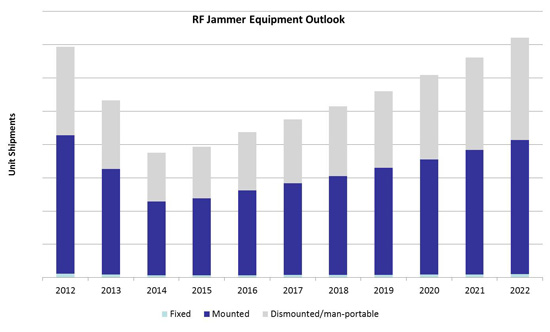What Is The Future Of RF Technology For Electronic Warfare Systems?
By Asif Anwar

There are some common themes that span across electronic warfare (EW), radar, and communications that are going to underpin future system design. These include the ability to operate across wider bandwidths and at higher frequencies while generating suitable output power in the transmit chain or offering sufficient low noise capabilities in the receiver. Practical requirements related to portability, flexibility, and modularity also dictate design, and other considerations include cost and reliability. This can all arguably be categorized under the SWaP-CR (size, weight, and power – cost, reliability) moniker and can be applied across EW, radar, and communications system design.
From a component perspective, the choice between using solid state semiconductors and tube-based solutions has also traditionally been dictated by system design requirements.
Solid-state technologies have typically been divided between solutions that are able to operate across a broad range of frequencies and those able to provide high output powers. This has traditionally resulted in solid-state solutions being restricted to specific end applications with technologies chosen based on best fit solutions related to frequency and power output requirements.
Travelling-wave tube (TWT) based solutions, on the other hand, have been able to provide the widest range of capabilities with broadband performance and high output powers, and they are generally able to offer higher overall system efficiencies. However, these technologies typically require specialized production expertise, and operation requires very high voltage supplies. Additionally, practical utilization has traditionally been restricted in terms of supporting systems requiring small form factors.
Global spending on EW is forecasted to grow to over $9.3 billion through 2022. With troop withdrawals in Iraq (complete) and Afghanistan (ongoing), spending on land/ground-based EW platforms and systems will see a sharp decline, as the total number of land-based electronic attack (EA) equipment (e.g. jammers) shipments dropping by 46 percent.
However, the withdrawal from these theaters will not change the general trends towards asymmetric warfare, and the use of improvised explosive devices (IEDs) will continue to proliferate, as they become a common weapon of choice for criminal gangs, insurgencies, and terrorists with global reach. This will lead to the market demand recovery for land-based EW systems. Nations will look to leverage the experience gained from Iraq and Afghanistan to allow troops to operate in similar situations moving forwards to counteract the threats of IEDs and radio-controlled IEDs (RCIEDs). The evolution of platforms will move beyond jammers that simply barrage the environment with signals, simultaneously blocking friendly communications, to selective and reactive jamming capabilities.
There will also be a move towards dismounted and portable jammers that will allow the development of smaller, lightweight personal protection devices. Vehicle-mounted and man-portable units will continue to account for close to 100 percent of this demand. Land-based EW (EA) equipment used for jamming is typically focused on communications frequencies, and this is reflected by the increasing emphasis on providing capabilities that can cover as much of the spectrum as possible. Finally, there will be development of multimode equipment that merges counter-IED (C-IED) and communications jamming.
The move towards wideband capabilities coupled with portability requirements has driven a move towards solid-state solutions with gallium nitride (GaN) technology, which is firmly entrenched as an enabling technology for land-based EW systems. The overall resultant market for semiconductor components will grow at a compounded annual growth rate (CAGR) of 6.4 percent through 2022. EW systems for naval and airborne platforms are also developing new capabilities based on emerging technologies. The typical emphasis for these systems is on jamming and/or identifying radar and other electronic signals to enable operations in conventional theatres. Some examples include the U.S. Surface Electronic Warfare Improvement Program (SEWIP), which is designed to upgrade the AN/SLQ-32 EW system for EW defense against cruise missiles and other radar threats. For airborne platforms, the next-generation jammer is intended to underpin an open architecture, software-driven approach to EW/EA systems that could be employed across a range of platforms, including next generation stealth fighters, bombers, and other special mission aircraft.

Other component level research includes ongoing efforts to develop mixed signal digital receivers that will enable ultra-fast tuning, high dynamic range, and data processing capabilities for EW systems. For RF-based EW systems, the trends point towards what may be described as a “no channel” concept, in which the systems are tasked with looking at the complete frequency range. The potential for phased arrays (already used extensively for radar systems) to be used in EW applications is also emerging rapidly, driven by a need to operate across wider bandwidths and higher frequencies, while adapting to a more complex and congested signal environment.
More information on this topic is available in the report Land-based EW (EA) and Components Forecast 2012-2022, which details global defense expenditure trends segmented on a regional basis before expanding on the expected spending on EW incorporating systems, hardware, support, and related services with a focus on the land domain.
A complementary webinar replay that looks at the future outlook for land-based EW systems in terms of market outlook and technology trends can also be found at here.
